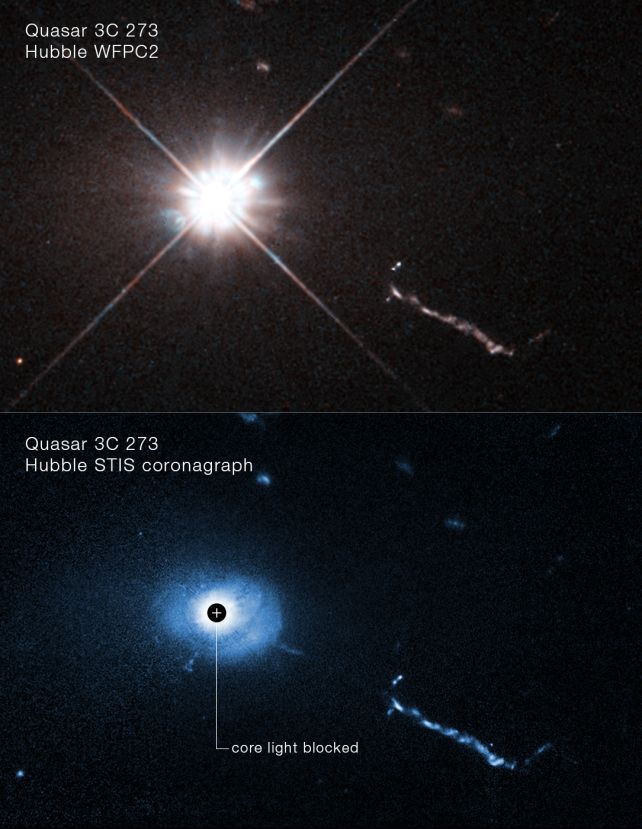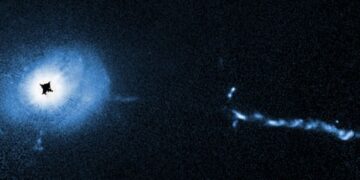Astronomers have achieved an extraordinary milestone by capturing the closest and most detailed image of one of the universe’s brightest objects—quasar 3C 273. Located 2.5 billion light-years away, this cosmic beacon is one of the closest quasars to Earth and an essential window into the mysteries of our universe.
What Are Quasars and Why Do They Matter?
Quasars are among the most luminous and awe-inspiring objects in the cosmos. Powered by supermassive black holes at the centers of distant galaxies, they emit light equivalent to trillions of Suns, making them visible across vast cosmic distances. Despite their brightness, quasars remain shrouded in mystery due to the intense glare that often obscures their finer details.
At the heart of a quasar lies a supermassive black hole consuming vast amounts of gas and dust. As this material spirals into the black hole, it forms an accretion disk that radiates immense energy. This intense luminosity allows astronomers to study the extreme environments around black holes, providing insights into the processes that shaped the early universe.
The Groundbreaking Observation of 3C 273
Using Hubble’s Space Telescope Imaging System (STIS), researchers employed a clever technique to overcome the quasar’s intense brightness. By creating a makeshift coronagraph, they blocked the blinding central light, allowing the surrounding features to come into focus. This approach is akin to shielding your eyes from a flashlight to see the room around it.

The result? An eightfold improvement in resolution, revealing structures within a radius of 16,000 light-years from the quasar’s center. For the first time, scientists observed small satellite galaxies and chunks of material being absorbed by 3C 273. They also discovered a new core jet and an enigmatic L-shaped filament, whose origins remain a mystery.
Key Findings and Their Implications
One of the most significant revelations from the 3C 273 observation is the detailed imaging of its astrophysical jet. This jet, extending 300,000 light-years into intergalactic space, appears to accelerate as it moves away from the black hole. Such behavior defies expectations and challenges existing models of jet dynamics.
These observations also provide a closer look at the quasar’s host galaxy, revealing interactions between the quasar and its surroundings. The discovery of satellite galaxies and material streams offers clues about how quasars acquire their fuel and how they influence their host galaxies.
The L-shaped filament, a previously unseen structure, adds another layer of intrigue. Its nature and role in the quasar’s dynamics are unknown, presenting an exciting avenue for future research.
Broader Implications for Astronomy
The findings from 3C 273 extend beyond a single quasar. They provide a framework for studying other quasars and active galactic nuclei (AGN), which share similar characteristics. By understanding the processes at play in 3C 273, astronomers can refine models of black hole behavior and galaxy evolution.
Quasars also serve as cosmic lighthouses, illuminating the intergalactic medium and tracing the distribution of matter in the universe. Studying their jets and host galaxies offers insights into the large-scale structure of the cosmos.
The observation of 3C 273 demonstrates the potential of advanced imaging techniques to unlock hidden details in the universe. It sets the stage for future missions, such as the James Webb Space Telescope (JWST), to delve even deeper into the mysteries of quasars and their role in cosmic evolution.
Future Directions in Quasar Research
The success of the Hubble observations paves the way for further studies of 3C 273 and other quasars. Infrared observations with the JWST could reveal additional details about the quasar’s structures, particularly in regions obscured by dust. The enigmatic L-shaped filament, for example, could be better understood through multi-wavelength analysis.
Conclusion
The unprecedented close-up of quasar 3C 273 marks a significant milestone in the study of these luminous cosmic beacons. By revealing intricate structures and dynamics around one of the brightest quasars, this breakthrough enhances our understanding of black holes, galaxy interactions, and the fundamental forces shaping the universe.
Reference
3C 273 host galaxy with Hubble Space Telescope coronagraphy⋆



















